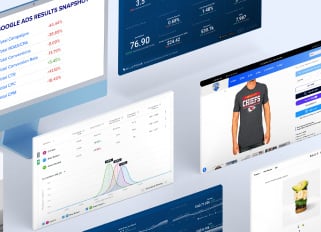
What is Google Ads Performance Max?
Google Ads Performance Max has been touted as a game-changer for businesses looking to enhance their advertising efforts. With its promise of automation, cross-channel advertising, and smarter audience targeting, this campaign type is the latest evolution in Google Ads.
But what exactly is Google Ads Performance Max, and how can you leverage it to maximize ad reach and results?
This guide will provide a detailed breakdown of everything you need to know about Performance Max campaigns, including their features, benefits, setup process, and how they stack up against other campaign types. Whether you’re an e-commerce business or a small enterprise looking to simplify ad management, this post will help you determine if Performance Max is the right fit for your marketing strategy.
What is Performance Max and How Does it Work?
Google Ads Performance Max is an all-in-one campaign type designed to help businesses reach customers across multiple Google platforms. From Search and Display to YouTube, Gmail, and Discover, Performance Max uses advanced machine learning to create personalized ads and deliver them to the most relevant audiences.
Key Features of Performance Max
- Cross-Channel Reach: Advertise seamlessly across Google-owned channels without needing to set up individual campaigns.
- Enhanced Automation: Harness Google’s AI to optimize ad placements, bidding strategies, and even assets to drive the best results.
- Intent-Driven Targeting: Use audience signals and data-based intent to reach users who are most likely to take action.
- Unified Campaign Management: Manage your entire advertising portfolio under one campaign for streamlined oversight and insights.

How Does Performance Max Differ From Traditional Campaigns?
Unlike traditional Search or Display campaigns, Performance Max consolidates all your advertising efforts into a single system. Instead of focusing on one network or audience, it automatically shifts resources and prioritizes where ads will perform best. Overall, it’s a hands-off solution for advertisers who want to maximize reach without micromanaging multiple campaigns.
Benefits of Using Performance Max
Performance Max is growing in popularity because of its significant advantages, particularly for businesses striving for efficiency and scalability in their advertising efforts.
Increased Automation & Optimization
With Performance Max, Google’s machine learning takes the reins in optimizing your creatives, targeting, and bids. It uses real-time data to make smarter decisions, ensuring that your ads are always displayed at the right time, place, and to the right audience.
Better Audience Targeting
Performance Max leverages audience signals like intent data, demographics, and online behaviors to hyper-target potential customers. This precision can significantly enhance ROI by ensuring your ad spend goes toward users who are most likely to convert.
Cross-Channel Ad Placement
Through a single campaign, your ads can seamlessly run across Google’s entire ecosystem, reaching users wherever they spend their time online. This not only simplifies the process for advertisers but also ensures you’re visible on multiple platforms, amplifying brand reach.
Ideal for E-commerce Innovations
For e-commerce businesses, Performance Max integrates effortlessly with Google Merchant Center to showcase products via Shopping ads. This creates a tailored experience for customers and boosts purchase intent.
How to Set Up Performance Max Campaigns
Curious about where to start? Here's a step-by-step guide to help you create a Performance Max campaign that truly performs.
Step 1: Log into Google Ads
Sign in to your Google Ads account and select ‘+ New Campaign.’
Step 2: Choose a Campaign Goal
You'll be prompted to choose a campaign goal. Performance Max campaigns support several objectives, including sales, leads, app promotion, and website traffic.
Step 3: Choose Your Conversion Goals
Next, choose the conversion goals for your campaign. These can include phone calls, online purchases, or other actions you want users to take.
Step 4: Select Performance Max Campaign Type
When you select the campaign type selection, choose "Performance Max" and name your campaign.
Step 5: Set Your Budget and Bidding
For Performance Max campaigns, Google automatically prioritizes "conversion value." However, you can set a target return on ad spending if you choose.
Step 6: Choose Your Campaign Settings
On the next page, you'll choose your campaign settings. These include location targeting, language targeting, and the URLs to which you want to send traffic. Here's a pro tip: you can exclude specific URLs from your site or send traffic to specific URLs.
Step 7: Create Ad Assets
Finally, on the ad asset page, you'll notice that the ad setup process looks completely different from setting up your standard search ads or display ads. You'll name each asset group and then set the following: images, videos, logos, headlines, descriptions, and the final URL.
It's essential to preview the ads under each ad type. If you don't create a video for YouTube Ads, Google will create one. It's best to put together even a short 30-second clip so that you can control your ad inventory.
Best Practices for Performance Max and Campaign Set-Up
Performance Max campaigns are a great way to optimize your Google Ads campaigns and achieve your business goals. To get the most out of them, follow the best practices outlined below.
Use Performance Max in Conjunction with Other Search Campaigns
One of the best practices for Performance Max is using it with other search campaigns. If the query matches a keyword you're bidding on, your search campaign will show its ad. However, if it doesn't match exactly, Google will show either the search or Performance Max ads (whichever has the highest Ad Rank score). This way, you can maximize your ad reach and increase your chances of getting conversions.
Choose the Right Bidding Strategy
It is crucial to select the right bidding strategy that aligns with your business goals. If you want to get the most conversions possible, use the "Maximize Conversions" strategy. Conversely, if you value specific conversions more than others, such as leads over phone calls, use the "Maximize Conversion Value" strategy.
Optimize Your Audience Signals
By using data such as Customer Match/Audience lists or Audience Signals, Google can quickly discover which new customers and audiences to target through machine learning. Make sure you optimize your audience signals to reach the right target audience and improve your campaign's performance.
Use Final URL Expansion
Use "Final URL Expansion" to customize ads based on audience queries, even if not bidding on keywords. Google chooses the best landing page and generates dynamic headlines and descriptions. To control which pages Google determines, use "URL Exclusion" to restrict specific URLs.
Add as Many Assets as You Can
One of the best practices for Performance Max is to supply as many assets as possible. Upload as many headlines, descriptions, target signals, match lists, high-quality videos, and photos as feasible. This will give Google more options when optimizing your Performance Max campaign.
Ensure you have at least five versions of text, video, and image assets to increase ad strength.
Keep Your Visual Content Fresh and Relevant
Visual content is essential for connecting with your users and capturing their attention. Keep your content fresh by regularly uploading new, highly relevant, and creative assets. Additionally, pay attention to how well your investments are performing and replace the ones that aren't performing well.
Optimize Your Asset Groups
If you're targeting multiple products, try focusing on only one for each asset group so it can be as personalized as possible. You can have a maximum of 100 asset groups per campaign. However, ensure you have enough budget, as the more asset groups you have, the more you'll need.
Use Campaign Exclusions
Another best practice for Performance Max is using campaign exclusions. This allows you to exclude irrelevant groups, placements, and keywords, improving ad spend efficiency and ROI.
Ensure Your Data Feed is Up to Scratch
It's crucial to ensure that your data feed is up to scratch to optimize your campaign performance. Ensure your data feed is comprehensive, accurate, and up-to-date, and review it regularly to ensure it's optimized.
Commit to Your Campaigns
Finally, commit to your campaigns and keep them running for at least six weeks. This way, Google will have enough time to learn your strategies.
Pros and Cons
Performance Max can be a valuable tool for businesses looking to improve their ad performance. However, it also has drawbacks. This section will discuss the benefits and disadvantages of using Google Performance Max to help you determine whether it is right for your business.
Pros
- Easier Optimization: Performance Max automatically adjusts your budget and bids across all of Google's advertising platforms to boost online leads and conversions. You only need to set your budget, goals, and conversions to measure, and Google's machine-learning technology does the rest.
- Increased Reach: Performance Max offers greater potential for increased reach by showing your ads across Google's entire network.
- New Audience Segments: Performance Max provides access to new audience segments using the search engine's real-time understanding of consumer intent, preferences, and behavioral characteristics across all channels.
- Time-Saving: With Google running your campaigns, you have more time for other tasks.
- Creative Ads: Performance Max creates unique and innovative ads by combining your assets for each campaign.
 Cons
Cons
- Limited Campaign Visibility: There needs to be more visibility into how the budget is distributed among different channels or types of visitors. This can create uncertainty for advertisers, as they may achieve great results without understanding why or experience a sudden decline in performance without any explanation.
- Ad Cannibalization: Performance Max can cannibalize some of your other campaigns and claim credit for their excellent results without proper monitoring. This makes it difficult to measure the actual value Performance Max brings.
- Poor Visibility on Search Terms and Locations: Performance Max offers more information on campaign triggers than smart shopping. However, its level of detail still needs to be higher than that of standard shopping campaigns.
Comparing Performance Max With Other Google Ads Campaigns
How does Performance Max stack up against other campaign types?
Performance Max vs. Smart Campaigns
- Performance Max: Offers more robust automation and multi-channel priority.
- Smart Campaigns: Best for small businesses needing simple, Google-managed solutions.
Performance Max vs. Display Campaigns
- Performance Max: Prioritizes cross-channel reach and audience targeting.
- Display Campaigns: The focus is solely on visual ads across Google’s Display Network.
Performance Max vs. Search Campaigns
- Performance Max: Automates Search placements alongside other channels.
- Search Campaigns: Best for text-based ads targeting specific search queries.
The Future of Google Ads and Performance Max
As automation and AI continue to revolutionize digital marketing, Performance Max is poised to become even more integral to Google’s advertising ecosystem. In the coming years, expect better predictive analytics, more ad extensions, greater personalization options, and improved integrations with external platforms.
For e-commerce businesses, the rise of Performance Max signals a shift toward smarter, integrated advertising strategies and local campaigns that prioritize customer experience above all else.
FAQs
What is the difference between keyword-based search campaigns and Performance Max campaigns?
Keyword-based search campaigns target specific queries entered by users in search engines, while a single Performance Max campaign leverages automation and machine learning to optimize ad placements across multiple platforms, focusing on delivering more relevant ads for higher engagement.
Can Performance Max campaigns replace branded search campaigns?
While Performance Max campaigns can complement branded search campaigns, it is often best to use them in tandem. Branded search campaigns ensure your business dominates searches for your brand name, whereas Performance Max campaigns offer broader reach and advanced optimization for additional online sales opportunities.
How should I incorporate Performance Max into my existing search campaigns?
Integrating Performance Max with your existing search campaigns allows for a balanced strategy. Traditional campaigns allow you to control specific queries manually, while Performance Max captures untapped opportunities and drives incremental growth through automation.
How does Performance Max help create more relevant ads?
Performance Max uses machine learning to analyze audience behavior and data signals, enabling it to serve ads personalized to user intent. This results in more relevant ads that resonate with your target audience and improve overall campaign performance.
Is Performance Max effective for boosting online sales?
Yes, Performance Max is particularly effective for boosting online sales. By unifying ad placements across search, display, YouTube, and other Google networks, it maximizes visibility and conversion potential, driving scalable and efficient e-commerce growth.
In Summary
Performance Max is a powerful tool for optimizing digital advertising and driving online sales. By leveraging advanced automation and machine learning, it offers greater reach, creative ad options, and time-saving benefits compared to traditional Google Ads campaigns.
However, it's important to consider the potential drawbacks and weigh them against your specific business needs before deciding if Performance Max is right for you. With its promising future developments, it's clear that Performance Max will continue to play an integral role in the evolving landscape of Google Ads.
Ready to take your advertising strategy to the next level? Let BlueTuskr help you unlock the full potential of ecommerce SEO services, including Performance Max. Contact us today to get started!
Connect With Us
Recent Post

.png)





Tell us what you think!